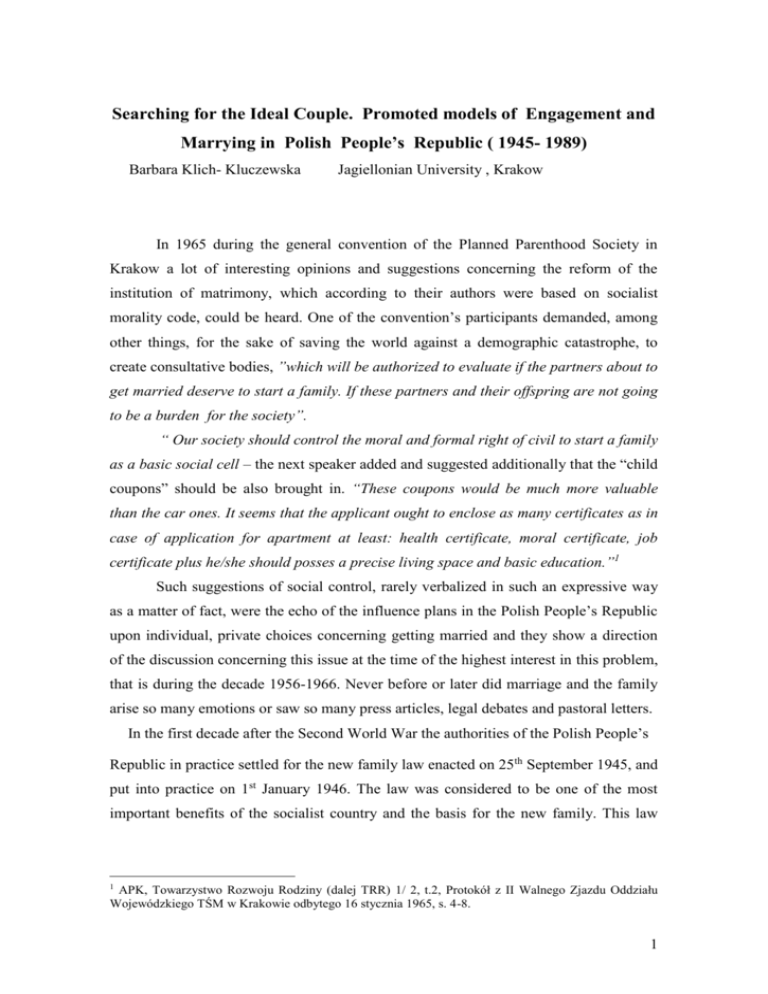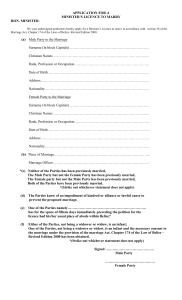Searching for the Ideal Couple. Promoted models of Engagement
advertisement

Searching for the Ideal Couple. Promoted models of Engagement and Marrying in Polish People’s Republic ( 1945- 1989) Barbara Klich- Kluczewska Jagiellonian University , Krakow In 1965 during the general convention of the Planned Parenthood Society in Krakow a lot of interesting opinions and suggestions concerning the reform of the institution of matrimony, which according to their authors were based on socialist morality code, could be heard. One of the convention’s participants demanded, among other things, for the sake of saving the world against a demographic catastrophe, to create consultative bodies, ”which will be authorized to evaluate if the partners about to get married deserve to start a family. If these partners and their offspring are not going to be a burden for the society”. “ Our society should control the moral and formal right of civil to start a family as a basic social cell – the next speaker added and suggested additionally that the “child coupons” should be also brought in. “These coupons would be much more valuable than the car ones. It seems that the applicant ought to enclose as many certificates as in case of application for apartment at least: health certificate, moral certificate, job certificate plus he/she should posses a precise living space and basic education.”1 Such suggestions of social control, rarely verbalized in such an expressive way as a matter of fact, were the echo of the influence plans in the Polish People’s Republic upon individual, private choices concerning getting married and they show a direction of the discussion concerning this issue at the time of the highest interest in this problem, that is during the decade 1956-1966. Never before or later did marriage and the family arise so many emotions or saw so many press articles, legal debates and pastoral letters. In the first decade after the Second World War the authorities of the Polish People’s Republic in practice settled for the new family law enacted on 25th September 1945, and put into practice on 1st January 1946. The law was considered to be one of the most important benefits of the socialist country and the basis for the new family. This law APK, Towarzystwo Rozwoju Rodziny (dalej TRR) 1/ 2, t.2, Protokół z II Walnego Zjazdu Oddziału Wojewódzkiego TŚM w Krakowie odbytego 16 stycznia 1965, s. 4-8. 1 1 gave marriage a secular character of a civil contract and it is correct to treat it as an ingredient of a revolution of manners. Statutorily this introduced a number of modern legal formulas, among other things it guaranteed the equality of rights and duties of both spouses (among other things the minimal age entitling one to get married was both in case of a woman and a man 18 years old), and in case of a permanent disintegration of life together, provided this did not threaten the wellbeing of a child, this gave the right to get divorced. This, however, was not a socialist or communist revolution. The only real achievement of the new authorities was putting this law into practice, since it was entirely based on the year 1929 projects which as the result of a very strong right-wing and the Church opposition could not be voted through in the Parliament in the interwar period. The necessity of introducing the law was primarily down to the fact that there were as many as five codes concerning marriage law within the territory of the Second Republic of Poland. 2 Those legal systems, to a greater or smaller extent relating to religious principles, were the legacy which the new country inherited after the period of partitionings. The system was complex, varied and it encouraged evading uncomfortable legal regulations. Standardizing the family and marriage law was thus indispensable, but the political context and the mode of introducing changes have forever weighed down on its evaluation. The arbitrary and turbulent nature of the period of taking over the power in Poland, which coincided with putting the new law into practice, could deprive a lot of its pre-war supporters of the feeling of satisfaction. Instead modernity, the code was associated with compulsory secularization of the society. Despite the fact that under Stalinism the issue of marriage and the family was not in any way one of the most essential problems raised during the meetings of KC PZPR (the Political Office of the Central Committee of the Polish United Workers` Party), that period brought about theoretical crystallization of the essence of ”new marriage”, which was reflected in the new family code enacted on 27th January 1950. It was emphasized that marriage was not a contract and that it was based on ”the socialist rules of the stability and equality of the spouses”. “In the capitalist society- the commentary on the code said - family, marriage, parents- children relationship are the issues of possesions and inheritance while institutions of marriage and family in the Austrıan part - ABGB (1811), Rusıan Poland – the famıly code (1836), the rusıan cıvıl code (1832), prusıan part - BGB (1896), Spisz and Orawa- the hungarıan code (1894): H. Warman, Prawo o rozwodzie i separacji, Warszawa 1939. 2 2 socialist society broke away from the influance of capitalist private property”. 3 The new code was for the most part didactic in nature. By proposing that marriage should obligatorily be clinched in the registry office ”publicly and ceremoniously” 4 it was aimed to strengthen the importance of the very civil act of getting married, which most of the Poles, used to ceremonious church weddings, did not pay much attention to. In how-to books and radio programmes of the first half of the 1950s there appeared opinions that the candidates to get married were first of all required to exhibit mutual love, which is lacking in capitalist marriage. The decline of matrimonial agencies was prophesized. ”Matrimonial newspapers, matrimonial agencies and newspaper advertisements offering lucrative marriages” 5 were to vanish just like prenuptial agreements. There were, however, no clues made popular as to the best age to get married or prenuptial sex life. As concerns sex education there was a conspiracy of silence, which was a derivative of both the specificity of communism, which reached Poland in a conservative-manner and pronatal (probirth) Stalinist formula, and the attitude of the Polish party activists themselves. The issue of choosing a spouse, which problem is of interest for us, appeared as it were incidental to purely political conflicts, and it was reflected in the propaganda supporting ”the ideologically homogeneous” marriages among the party members, especially those who on account of their position were to be a model for the society. Impossible as it was to test the feelings of the candidates for socialist spouses, the accusations of having no political awareness when choosing a lifetime partner could lead to punishing those who were criticized by means of the party’s reprimand. 6 The political awareness as well as the unanimity of viewpoints of the both spouses were also the most distinct sign of a happy relationship as shown in socialist realist film and literature. After the Thaw`56 preparation of young Poles for playing the vital role of prospective husbands and wives appeared as essential for the general civil education in the context of critisim over Stalinism’s distortions on the one hand and setting up the programme of the creation of a new citizen aware of his/her social and national duties on the other. The debate was concerned in the rising State – Catolic Church conflict of Mędrzecka Ewa, Małżeństwo i rodzina w Polsce Ludowej, Wydawnictwo Ministerstwa Sprawiedliwości Warszawa 1951, p. 5. 4 Ibidem, p.9. 5 Załkind L. A., Zdrowe małżeństwo, szczęśliwa rodzina, Warszawa 1953, p.22-23. 6 Sprawy te dotyczyły przede wszystkim żon - praktykujących katoliczek 3 3 interest and fester during the 60s. According to communist authorities it was the clash between „the modernity” and „the medieval superstitions”. The representatives of the Church used to label their activity as „a struggel against demoralisation”. Despite the obvious distinctions emphasized strongly by the both sides of conflict, we could find certain important similarities. The clergy and the communists stressed the influence of individual choices dealing with private sphere on the development of the social system. It was a result of preferences to collectivist conceptions of a human being in the marxist thought as well as many the trends of christian philosophy. The both sides set out to prevent couples from getting dıvorce. A divorce, the main reason for the condemnation of the 1945 family code by the Church, was not the socialist state’s achivement any more and started to be defıne as a „necessary evil” (in the near future dıvorce would appear as a chapter of popular criminalistic handbooks). At the turn of the 50s and 60s communist activists started to doubt rightness of rapid marriages, which were specially popular in the new industrial areas and, according to the statistics, usually broke up. In 1961 readers could still find the suggestion that „from morality and hygiene’s point of view you would better start your family early and run a modest life than irresponsibly get off with casual partners and indulge your primitive whims”7, but the authors of such opinions were in the minority. According to the new matrial code put into practis in 1964, the minimal age entitling men to get married rose to 21 years old. The ideal couple of “the new era” of socialist Poland was not the relationship of two persons devoted to socialism harmoniously but above all the relationship of responsible, unbelieving and free from illness or disease young Polish citizens. Prospective husband should begin with two years service in the army and next find the appropriate job, which would provide his potential family with proper living conditions. The equality of the spouses lost its preferential position. “Woman has usually difficulty in finding regular work and she used to devote to family. One way or another it is her husband’s duty to provide children for.” In this way they gave reasons for marriages of older men with younger women. What is probably the most important, the ideal both spouses broke off ties with Catolic Church. A.J. Majda, Wychowanie seksualne dzieci i młodzieży. Poradnik dla nauczycieli, wychowawców i rodziców, TŚM i PZWS Warszawa 1961, s.27-29. 7 4







